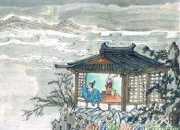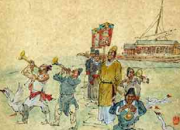有关简爱读后感英语版
时间:2021-08-31《简爱》这本小说,主要通过简.爱与罗切斯特之间一波三折的爱情故事,塑造了一个出生低微、生活道路曲折,却始终坚持维护独立人格、追求个性自由、主张人生平等、不向人生低头的坚强女性。下面和小编一起来阅读英文的吧!
有关简爱读后感英语版【1】
I first read "Jane Eyre" in eighth grade and have read it every few years since.
It is one of my favorite novels, and so much more than a gothic romance to me, although that's how I probably would have defined it at age 13.
I have always been struck, haunted in a way, by the characters - Jane and Mr.
Rochester.
They take on new depth every time I meet them...and their's is a love story for the ages.
Charlotte Bronte's first published novel, and her most noted work, is a semi-autobiographical coming-of-age story.
Jane is plain, poor, alone and unprotected, but due to her fierce independence and strong will she grows and is able to defy society's expectations of her.
This is definitely feminist literature, published in 1847, way before the beginning of any feminist movement.
Perhaps this is one of the reasons why the novel has had such a wide following since it first came on the market.
It is also one of the first gothic romances published and defines the genre.
Jane Eyre, who is our narrator, was born into a poor family.
Her parents died when she was a small child and the little girl was sent to live with her Uncle and Aunt Reed at Gateshead.
Jane's Uncle truly cared for her and showed his affection openly, but Mrs.
Reed seemed to hate the orphan, and neglected her while she pampered and spoiled her own children.
This unfair treatment emphasized Jane's status as an unwanted outsider.
She was often punished harshly.
On one occasion her nasty cousin Jack picked a fight with her.
Jane tried to defend herself and was locked in the terrifying "Red Room" as a result.
Jane's Uncle Reed had died in this room a little while before, and Mrs.
Reed knew how frightened she was of the chamber.
Since Jane is the narrator, the reader is given a first-hand impression of the child's feelings, her heightened emotional state at being imprisoned.
Indeed, she seems almost like an hysterical child, filled with terror and rage.
She repeatedly calls her condition in life "unjust" and is filled with bitterness.
Looking into the mirror Jane sees a distorted image of herself.
She views her reflection and sees a "strange little figure," or "tiny phantom." Jane has not learned yet to subordinate her passions to her reason.
Her passions still erupt unchecked.
Her isolation in the Red Room is a presentiment of her later isolation from almost every society and community.
This powerful, beautifully written scene never fails to move me.
Mrs.
Reed decided to send Jane away to the Lowood School, a poor institution run by Mr.
Brocklehurst, who believed that suffering made grand people.
All the children there were neglected, except to receive harsh punishment when any mistake was made.
At Lowood, Jane met Helen Burns, a young woman a little older than Jane, who guided her with vision, light and love for the rest of her life.
Jane's need for love was so great.
It really becomes obvious in this first friendship.
Helen later died from fever, in Jane's arms.
Her illness and death could have been avoided if more attention had been paid to the youths.
Jane stayed at Lowood for ten years, eight as a student and two as a teacher.
Tired and depressed by her surroundings, Jane applied for the position of governess and found employment at Thornfield.
The mansion is owned by a gentleman named Edward Fairfax Rochester.
Her job there was to teach his ward, an adorable little French girl, Adele.
Over a long period the moody, inscrutable Rochester confides in Jane and she in him.
The two form an unlikely friendship and eventually fall in love.
Again, Jane's need for love comes to the fore, as does her passionate nature.
She blooms.
A dark, gothic figure, Rochester also has a heart filled with the hope of true love and future happiness with Jane.
Ironically, he has brought all his misery, past and future, on himself.
All is not as it seems at Thornfield.
There is a strange, ominous woman servant, Grace Poole, who lives and works in an attic room.
She keeps to herself and is rarely seen.
From the first, however, Jane has sensed bizarre happenings at night, when everyone is asleep .There are wild cries along with violent attempts on Rochester's life by a seemingly unknown person.
Jane wonders why no one investigates Mrs.
Poole.
Then a strange man visits Thornfield and mysteriously disappears with Mr.
Rochester.
Late that night Jane is asked to sit with the man while the lord of the house seeks a doctor's help.
The man has been seriously wounded and is weak from loss of blood.
He leaves by coach, in a sorry state, first thing in the morning.
Jane's questions are not answered directly.
This visit will have dire consequences on all involved.
An explosive secret revealed will destroy all the joyful plans that Jane and Rochester have made.
Jane, once more will face poverty and isolation.
Charlotte Bronte's heroine Jane Eyre, may not have been graced with beauty or money, but she had a spirit of fire and was filled with integrity and a sense of independence - character traits that never waned in spite of all the oppression she encountered in life.
Ms.
Bronte brings to the fore in "Jane Eyre" such issues as: the relations between men and women in the mid-19 century, women's equality, the treatment of children and of women, religious faith and hypocrisy (and the difference between the two), the realization of selfhood, and the nature of love and passion.
This is a powerhouse of a novel filled with romance, mystery and passions.
It is at once startlingly fresh and a portrait of the times.
Ms.
Bronte will make your heart beat faster, your pulse race and your eyes fill with tears.











